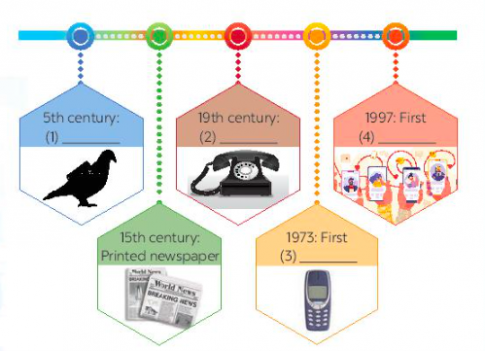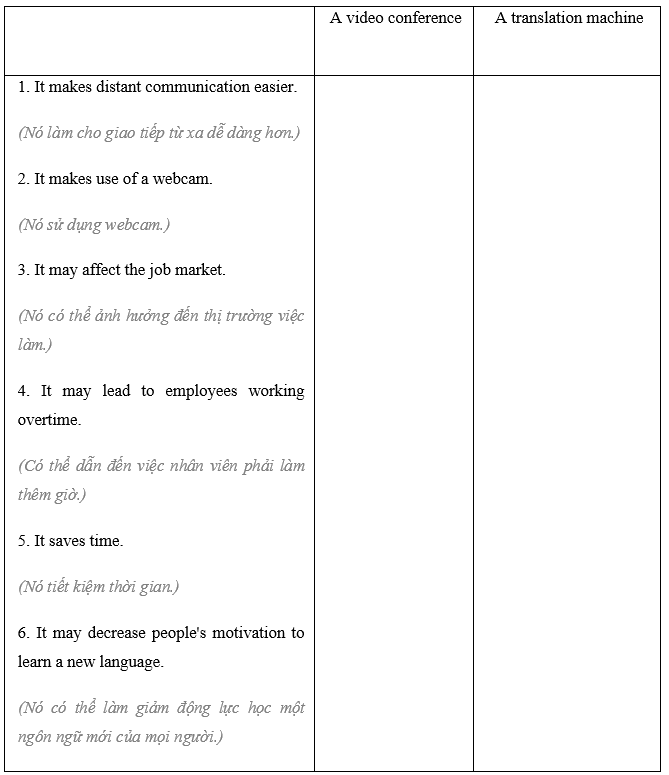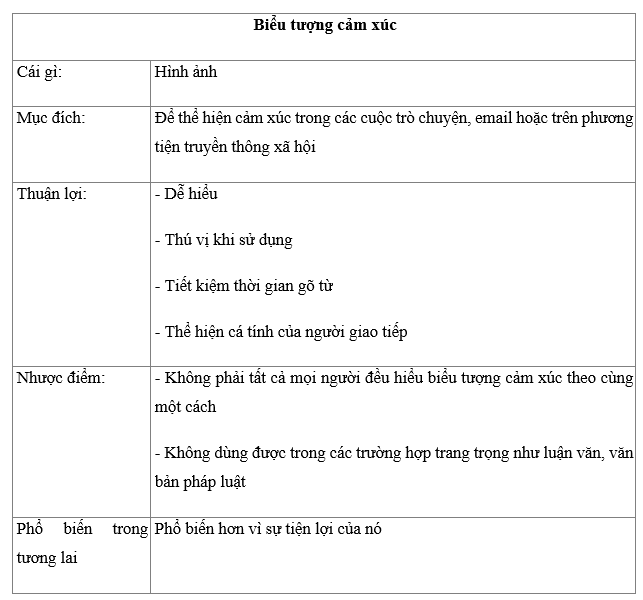Giải SGK, SBT Unit 10. Communication in the future Global Success
Giải SGK, SBT Unit 10 Global Success
1. Write the correct word or phrase from the box under each picture.
(Viết từ hoặc cụm từ chính xác từ hộp dưới mỗi bức tranh.)
|
voice message social network group call |
smartphone emojis holography |

3. Complete the sentences with the words from the box.
(Hoàn thành các câu với các từ trong hộp.)
|
translation real language instantly private |
1. Do you often send ________ messages to your friends?
2. Can learning English help you overcome the ________ barrier when living abroad?
3. Telephone helps you communicate in _________ time.
4. Do you think translators will lose their jobs when _________ machines become popular?
5. Many people reply to messages ________, but others take a long time to respond.
3. Complete the text with the prepositions from the box. Use each preposition only ONCE.
(Hoàn thành văn bản với các giới từ từ hộp. Chỉ sử dụng mỗi giới từ MỘT LẦN.)
| in on at for by |
I think smartphones will change a lot (1) _____ the near future. They will be much thinner. (2) _______ 2035, we might be able to roll a phone like a sheet of paper. They will become much smarter, too. They will be able to charge their battery automatically when we are (3) _______ home. They might check the latest news (4) _______ the Internet. We won't have to wait (5) _______ a long time for these super smartphones.
2. Read an interview with two students, Minh and Tom. Then tick (v) the speaker of each sentence.
(Đọc một cuộc phỏng vấn với hai sinh viên, Minh và Tom. Sau đó đánh dấu (v) người nói của mỗi câu.)
TELEPATHY
MC: Hi everyone. Today, I'll ask some members of the Technology Club to predict how people will communicate in the future. Let’s meet Minh and Tom.
Minh & Tom: Hi everyone.
MC: Minh and Tom, how do you and your friends keep in contact?
Minh: Well, we mostly text each other. We also send voice messages.
Tom: I often see my friends in person, but sometimes we call via the Internet.
MC: Do you think these ways of communication will still be popular in 50 years?
Tom: Not really. We'll use more advanced ways, like telepathy. We'll pass our thoughts to another person without talking and...
MC: Hold on. I think only a very few people may have this ability.
Minh: Yes, but in the future, everyone will be able to use telepathy. We'll wear a tiny device to catch our thoughts and send them to other people.
MC: Cool! But will there be any problems with telepathy?
Tom: Hmm, telepathy devices can “read” one’s mind, so bad people might take advantage of it to control someone else.
MC: Besides that, some people will be too lazy to even talk anymore.
|
Who says that …? |
Minh |
Tom |
|
1. he sends voice messages to friends |
|
|
|
2. he calls his friends by using the Internet |
|
|
|
3. everyone will be able to use telepathy in the future |
|
|
|
4. people need a small device to send their thoughts to others |
|
|
|
5. bad people can make use of telepathy to harm others |
|
|
2. Listen to an announcement about an exhibition. Complete each gap in the agenda with One word or a number.
(Nghe một thông báo về một cuộc triển lãm. Hoàn thành mỗi khoảng trống trong chương trình làm việc với một từ hoặc một số.)
EXHIBITION AGENDA
|
Event |
Where to go |
When to meet |
|
Opening ceremony |
Main Hall |
by (1) _________ a.m. |
|
History |
(2) ________ floor |
9:15 a.m. |
|
(3) ________ Time |
Tech Room |
(4) _______ a.m. |
|
animated film |
(5) ________ Room |
11:30 a.m. |
2. Fill in each gap with a word from the box to complete the passage.
(Điền vào mỗi khoảng trống với một từ trong hộp để hoàn thành đoạn văn)
|
text instantly language real social |
In 30 years, social robots will become popular. This kind of robot is special because it can perform many human tasks. For example, it can send a (1) ___________ message to its owner to remind them of dinner time. Some social robots may even have (2) ______________ network accounts and interact with other users in (3) ____________ time. Forthese robots, (4) _____________barriers are not a problem, so they can (5) ______________ reply to comments or messages in any language. It might be frightening because we won't know whether we are chatting with a human or a robot online!
3. Complete the sentences with the prepositions from the box. Tick V the sentences which have prepositions of time.
(Hoàn thành các câu với các giới từ từ hộp. Đánh dấu þ vào những câu có giới từ chỉ thời gian.)
|
in on for by opposite |
1. I talk to my mum _______ the phone every weekend.
2. Maria texted me that she would be home _______ 10 minutes.
3. Phong waited ________ an hour. Then he called Ann and said that he had to leave.
4. Where's Ms Lan? - She's in the _______ room. She's having a video conference.
5. Telepathy might be the most popular way to communicate ______ 2050.















